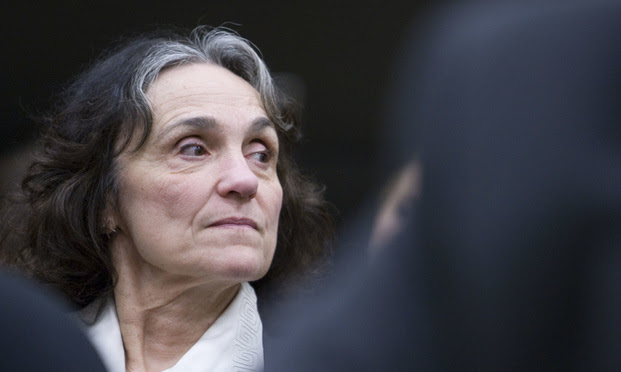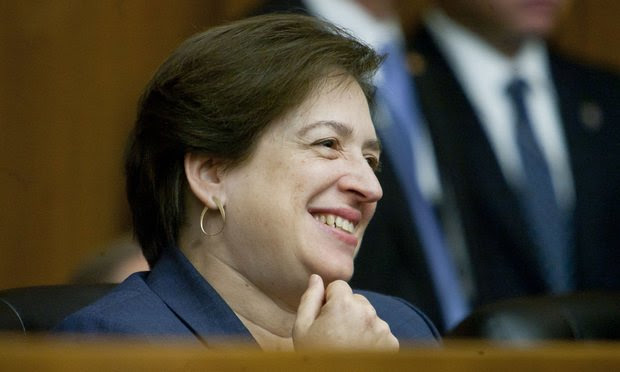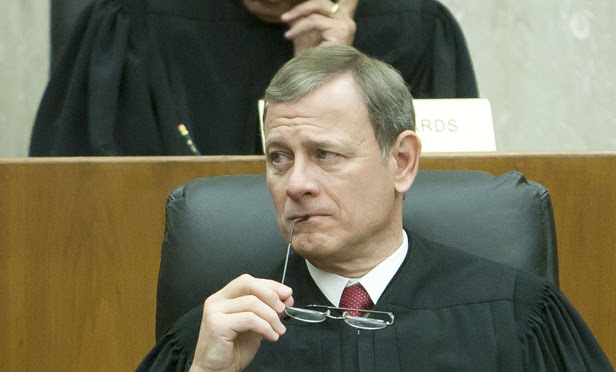Roberts Was Briefly Hospitalized After Fall | Two Key Officials Announce Retirement | Kagan's Pop Culture References | 'Severability' in Focus
Welcome to Supreme Court Brief -- Chief Justice Roberts was briefly hospitalized last month after an injury to his head, and the court says he is doing well now. Plus: two key officials at the court are retiring, and scroll down for a roundup of Justice Kagan's greatest pop culture hits. Thanks for reading, and your feedback is appreciated.
July 08, 2020 at 07:00 AM
9 minute read
Good morning and welcome to Supreme Court Brief. The justices may have opinions this morning, as they extend the term deeper into July. The chief justice has announced the retirements of two key court employees—Pamela Talkin, the court marshal, and Christine Fallon, reporter of decisions. Plus: Justice Kagan continues to lighten some of her opinions with pop culture references—scroll down for a roundup. And for SCOTUS headlines, including a report about Chief Justice Roberts's hospitalization last month.
Thanks for reading, and your feedback is welcome and appreciated. Contact Marcia Coyle at [email protected] and follow her on Twitter @MarciaCoyle.

Court's Path-Breaking Marshal and Reporter of Decisions to Retire
Before the coronavirus pandemic, the last day of a Supreme Court term featured the chief justice revealing from the bench court staff retirements and expressing gratitude to the court's employees for their work during the term. Although it was not the term's final day, two major retirement announcements came via email on Tuesday.
Pamela Talkin (above), the court marshal, and Christine Luchok Fallon, reporter of decisions, the first women to hold those positions, will retire July 31 and Sept. 25, respectively.
"These two have been so awesome for the court. A true loss for all of us," Hogan Lovells partner Neal Katyal tweeted.
Talkin has been the court's marshal since July 2001 and has been a constant presence in the courtroom in her morning coat during arguments. She called the courtroom to order with her "oyez, oyez" cry.
But there was so much more to her job. She was general manager, paymaster, and chief security officer, managing about 260 employees, including the Supreme Court Police Force that provides security for the justices and court staff. She also coordinated ceremonies—such as the investitures of new justices—and arranged special events.
Before coming to the court, Talkin was for six years the first deputy executive director of the Office of Compliance, the independent regulatory agency created by the Congressional Accountability Act of 1995, which applies the nation's labor and employment laws to Congress. From 1989-1995, she served as a member of the Federal Labor Relations Authority and from 1986 to 1989, she was the chief of staff at the United States Equal Employment Opportunity Commission. Talkin spent 47 years in federal service
"Over her tenure of nearly two decades, she has taken on many crucial projects—including the renovation of our court building and the modernization of our security practices—while overseeing the day-to-day operations of our facilities and police," Chief Justice John Roberts Jr. said in a statement. "We will miss hearing her cry the court at the beginning of each of our arguments sessions."
Fallon became reporter of decisions in 2011 after serving as the deputy reporter from 1989 to 2011. As the reporter, she has overseen the publication of 29 volumes of the United States Reports, and as the deputy reporter, she assisted in the editing and publication of an additional 72 volumes.
During her tenure, Fallon worked with court staff to ensure the editorial quality of the court's opinions. She also played an integral role in the Reporter's Office transition from a primarily paper-based process to one employing advancements in electronic publishing and digital records management.
In a 2012 post on the SCOTUSblog site, veteran Supreme court reporter Lyle Denniston called Fallon the court's "secret weapon" for helping the public understand quickly what the justices decided, Before any decision is released, he wrote, Fallon "has performed the exquisitely delicate task of writing a summary of the ruling, and doing it in a way that (1) gets it right, (2) does not leave out anything really critical, and (3), most important, is acceptable to the author whose flowing (or plodding) prose she has turned into plain English."
"Chris Fallon has performed a critical 'behind the scenes' role at the court in ensuring we employ consistent style conventions and checking the accuracy of our legal citations, as well as managing the publication of the bound volumes of U.S. Report," Roberts said. "My colleagues and I deeply appreciate her tireless dedication to ensuring the quality of our opinions, as Deputy Reporter and Reporter, over the past three decades." —Marcia Coyle

Justice Kagan, Pop Culture Expert
The closing weeks of a Supreme Court term can be an intense period for the justices, and this term with its huge docket of major cases and telephonic arguments perhaps more so than most. But Justice Elena Kagan manages to inject some lighter moments into dense opinions as she continues her evolution as the court's pop culture expert.
Kagan once remarked that her clerks "keep me in line." They tell her if "too much snark" creeps into her opinions. "Most of my best lines end up on the cutting-room floor," Kagan said last year in public remarks.
What follows is a roundup of some of Kagan's pop culture references.
>> The nation's first contested presidential election occurred in 1796 and resulted in President John Adams and the Vice President Thomas Jefferson. The two men represented different political parties. Referring to an HBO popular series starring Julia Louis Dreyfus, Kagan wrote, "One might think of this as fodder for a new season of Veep."
Four years later, Kagan noted, electors produced a tie between Jefferson and Aaron Burr for president even though they had run as president and vice president, respectively. Kagan wrote: "Alexander Hamilton secured his place on the Broadway stage—but possibly in the cemetery too—by lobbying Federalists in the House to tip the election to Jefferson, whom he loathed but viewed as less of an existential threat to the Republic." (Chiafalo v. Washington)
>> "The majority offers the civics class version of separation of powers—call it the Schoolhouse Rock definition of the phrase. See Schoolhouse Rock! Three Ring Government." (Seila Law v. CFPB)
>> In a 2015 case involving a fisherman accused of destroying evidence of an illegal catch, she wrote, "A fish is, of course, a discrete thing that possesses physical form. See generally Dr. Seuss, One Fish Two Fish Red Fish Blue Fish (1960)." (Yates v. United States)
>> In a 2015 patent case involving a Spider-Man toy, Kagan wrote: "What we can decide, we can undecide. But stare decisis teaches that we should exercise that authority sparingly. Cf. S. Lee and S. Ditko, Amazing Fantasy No. 15: 'Spider-Man,' p. 13 (1962) ('[I]n this world, with great power there must also come—great responsibility')." (Kimble v. Marvel)
>> Her opinion in a 2013 Armed Career Criminal Act case prompted Kagan to turn to the board game Clue, where she wrote: "In fact, every element of every statute can be imaginatively transformed as the Ninth Circuit suggests … Think: Professor Plum, in the ballroom, with the candlestick?; Colonel Mustard, in the conservatory, with the rope, on a snowy day, to cover up his affair with Mrs. Peacock?" (Descamps v. United States) —Marcia Coyle

Supreme Court Stories: What We're Reading
Chief Justice John Roberts Was Hospitalized Last Month After Injuring His Head in a Fall. "The Chief Justice was treated at a hospital on June 21 for an injury to his forehead sustained in a fall while walking for exercise near his home. The injury required sutures, and out of an abundance of caution, he stayed in the hospital overnight and was discharged the next morning. His doctors ruled out a seizure. They believe the fall was likely due to light-headedness caused by dehydration," the court said in a statement about the previously undisclosed incident. [The Washington Post]
Gorsuch, Thomas Look Lonely on Whether to Strike Obamacare. "Justices Clarence Thomas and Neil Gorsuch appear to be in the minority among court conservatives open to sinking an entire law when rejecting a piece of it if a Monday decision is any guide, as the Supreme Court prepares to take up another challenge to the Affordable Care Act next term." [Bloomberg Law] More here at the NLJ: Justices' Fresh Views on 'Severability' Could Boost Obamacare Defenders
SCOTUS Abortion GVR's Suggest June Medical Narrowed The Right. "[I]t is possible that five Justices believe that they have now not only rejected the Whole Woman's Health balancing test but have also raised the threshold for finding a substantial obstacle/undue burden," law professor Michael Dorf writes. [Dorf on Law]
How Big Law Teamed Up to Clinch Supreme Court Dreamer Victory. "Lawyers across the U.S. from Gibson, Dunn & Crutcher, Jenner & Block, and Covington & Burling worked on the case for years." [Bloomberg Law]
Supreme Court to Decide Federal Courts' Authority Over Claims From Overseas Atrocities. "The Supreme Court agreed Thursday to decide whether federal courts can hear claims stemming from atrocities committed overseas, including the looting of Jewish property during the Holocaust by German and Hungarian authorities and the exploitation of enslaved children from Mali in cultivating cocoa for multinational food processors." [WSJ]
Justices Won't Disturb Equal-Pay Ruling That Business Advocates Challenged. The justices denied review in the Equal Pay Act case Yovino v. Rizo, leaving in place a ruling by the U.S. Court of Appeals for the Ninth Circuit. That appellate court had held that employers could not use prior salary as a defense to unequal pay for equal work. [NLJ]
How the Supreme Court Could Overturn Roe—While Claiming to Respect Precedent. "June Medical asked the justices to do too much too soon, reversing a recent ruling and making a mockery of the court's claim to be above the partisan fray. But abortion opponents have an obvious path ahead: laws that rely on scientific uncertainty. This strategy could significantly undercut abortion rights and lay the groundwork for the ultimate reversal of Roe. Just as important, it offers the court the opportunity to do so while plausibly claiming to care about stare decisis," law professor Mary Ziegler writes. [The Washington Post]
This content has been archived. It is available through our partners, LexisNexis® and Bloomberg Law.
To view this content, please continue to their sites.
Not a Lexis Subscriber?
Subscribe Now
Not a Bloomberg Law Subscriber?
Subscribe Now
NOT FOR REPRINT
© 2025 ALM Global, LLC, All Rights Reserved. Request academic re-use from www.copyright.com. All other uses, submit a request to [email protected]. For more information visit Asset & Logo Licensing.
You Might Like
View All
Supreme Court Brief: Slack Securities Dispute | Comstock Act Revival? I 'Incentive Awards'
10 minute read
'Hurdles' Abound: Legal Teams Guiding Psychedelics Companies Face Unique Challenges

3M's Earplug Trial Team, in 'Midst of an Active COVID-19 Outbreak,' Requests Bellwether Delay
5 minute readLaw Firms Mentioned
Trending Stories
- 1New FCC Chair Hires Section 230 Critic as General Counsel
- 2Sylvia Favretto Elevated to Mysten Labs’ General Counsel
- 3Vanessa Roberts Avery Rejoins McCarter & English
- 4Charlie Javice Jury Will Not See Her Texts About Elizabeth Holmes
- 5Unit Owners Sued Board For Failure To Maintain Adequate Fire Insurance: This Week In Scott Mollen’s Realty Law Digest
Who Got The Work
J. Brugh Lower of Gibbons has entered an appearance for industrial equipment supplier Devco Corporation in a pending trademark infringement lawsuit. The suit, accusing the defendant of selling knock-off Graco products, was filed Dec. 18 in New Jersey District Court by Rivkin Radler on behalf of Graco Inc. and Graco Minnesota. The case, assigned to U.S. District Judge Zahid N. Quraishi, is 3:24-cv-11294, Graco Inc. et al v. Devco Corporation.
Who Got The Work
Rebecca Maller-Stein and Kent A. Yalowitz of Arnold & Porter Kaye Scholer have entered their appearances for Hanaco Venture Capital and its executives, Lior Prosor and David Frankel, in a pending securities lawsuit. The action, filed on Dec. 24 in New York Southern District Court by Zell, Aron & Co. on behalf of Goldeneye Advisors, accuses the defendants of negligently and fraudulently managing the plaintiff's $1 million investment. The case, assigned to U.S. District Judge Vernon S. Broderick, is 1:24-cv-09918, Goldeneye Advisors, LLC v. Hanaco Venture Capital, Ltd. et al.
Who Got The Work
Attorneys from A&O Shearman has stepped in as defense counsel for Toronto-Dominion Bank and other defendants in a pending securities class action. The suit, filed Dec. 11 in New York Southern District Court by Bleichmar Fonti & Auld, accuses the defendants of concealing the bank's 'pervasive' deficiencies in regards to its compliance with the Bank Secrecy Act and the quality of its anti-money laundering controls. The case, assigned to U.S. District Judge Arun Subramanian, is 1:24-cv-09445, Gonzalez v. The Toronto-Dominion Bank et al.
Who Got The Work
Crown Castle International, a Pennsylvania company providing shared communications infrastructure, has turned to Luke D. Wolf of Gordon Rees Scully Mansukhani to fend off a pending breach-of-contract lawsuit. The court action, filed Nov. 25 in Michigan Eastern District Court by Hooper Hathaway PC on behalf of The Town Residences LLC, accuses Crown Castle of failing to transfer approximately $30,000 in utility payments from T-Mobile in breach of a roof-top lease and assignment agreement. The case, assigned to U.S. District Judge Susan K. Declercq, is 2:24-cv-13131, The Town Residences LLC v. T-Mobile US, Inc. et al.
Who Got The Work
Wilfred P. Coronato and Daniel M. Schwartz of McCarter & English have stepped in as defense counsel to Electrolux Home Products Inc. in a pending product liability lawsuit. The court action, filed Nov. 26 in New York Eastern District Court by Poulos Lopiccolo PC and Nagel Rice LLP on behalf of David Stern, alleges that the defendant's refrigerators’ drawers and shelving repeatedly break and fall apart within months after purchase. The case, assigned to U.S. District Judge Joan M. Azrack, is 2:24-cv-08204, Stern v. Electrolux Home Products, Inc.
Featured Firms
Law Offices of Gary Martin Hays & Associates, P.C.
(470) 294-1674
Law Offices of Mark E. Salomone
(857) 444-6468
Smith & Hassler
(713) 739-1250







